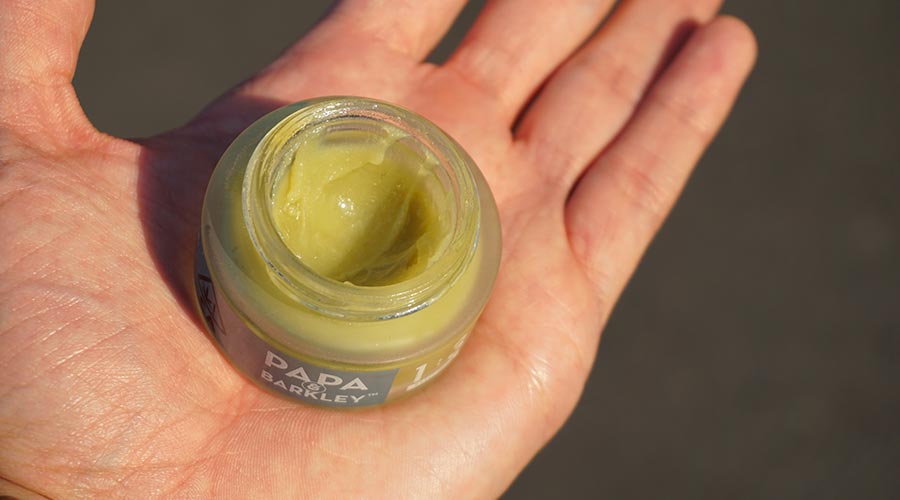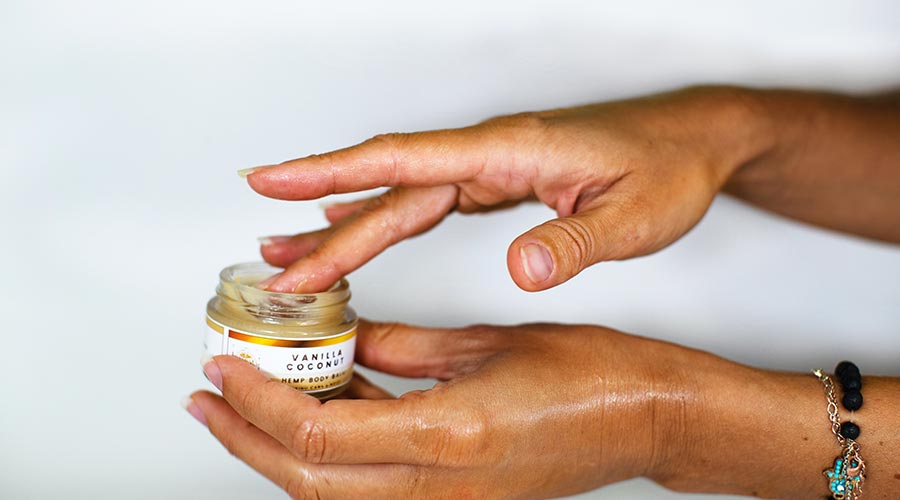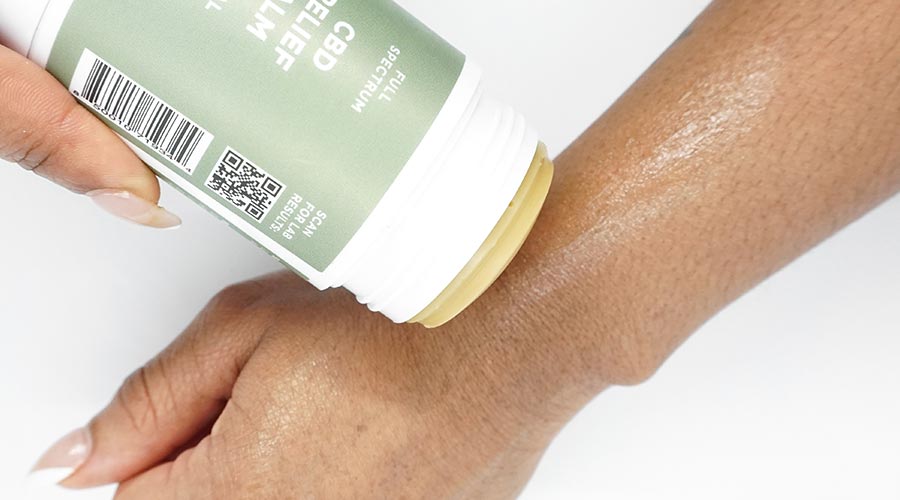There are so many different ways to enjoy weed, from smoking and vaping to eating edibles and back. However, if THC isn’t really your thing and you’re looking for different ways to get the power of cannabinoids into your system, you’re in the right place. Read on to explore everything you need to know about cannabis topicals, including what they are, how they work, and why we love them.
What are cannabis topicals?
Cannabis topicals, also known as topical THC or topical CBD products, are cannabis-infused lotions, balms, creams, salves, sprays, oils, bath bombs, or patches designed to be applied directly to the skin. Unlike smoking or eating cannabis, topicals are intended for localized effects and relief without causing you to feel high.


Topical cannabis products are typically infused with cannabinoids, including THC (tetrahydrocannabinol) and CBD (cannabidiol), as well as other beneficial compounds found in cannabis, like terpenes, vitamins, and other good-for-skin ingredients. THC is the high-inducing compound in cannabis, while CBD won’t cause you to feel high, but has potential therapeutic effects on the endocannabinoid system (ECS).
When applied to the skin, topicals interact with the endocannabinoid receptors present in the skin’s surface and underlying tissues. These receptors are part of the body’s endocannabinoid system, which plays a role in regulating various physiological processes, including mood, inflammation, sleep, appetite and immune response.
How do topicals work?
Cannabis topicals work by interacting with the ECS, which has receptors in countless places throughout your body and central nervous system. As the largest organ in your body, your skin and the underlying tissues also have endocannabinoid receptors. THC and CBD interact with two main types of receptors in the ECS: CB1 receptors, primarily located in the brain and central nervous system; and CB2 receptors, predominantly found in peripheral tissues, including the skin.
When you apply a cannabis-infused topical product to your skin, the cannabinoids in the product bind to the CB2 receptors in the skin to promote effects. For the most part, cannabis topicals are formulated to help with things like localized pain or inflammation and sore muscles. Evidence suggests that both THC and CBD might have both anti-inflammatory and pain-relieving effects. However, other studies suggest that cannabinoids may also help with inflammatory skin conditions like acne, eczema, and psoriasis.


This interaction does not lead to the high typically associated with THC, as the cannabinoids do not enter the bloodstream when applied topically. Instead, they stay confined to the localized area where you apply the topical. However, some topicals, known as transdermals, are able to make their way into your bloodstream which can make you feel a little euphoric or high, though it won’t be anywhere near as strong as a high from smoking weed or eating edibles. Regardless of what type of topical you use, if it contains THC there is a possibility of trace amounts being absorbed through the skin, which may lead to very mild effects or show up on drug tests. CBD-only topicals, on the other hand, do not produce any type of high since CBD is non-intoxicating.
Overall, cannabis topicals offer a localized and non-intoxicating way to potentially benefit from the therapeutic properties of cannabis. As with any cannabis product, it’s essential to use topicals responsibly and talk to your doctor before using them. Cannabinoids can’t replace actual medicines, and you should always use them for pain or inflammation under the supervision of your doctor.
What are the different types of cannabis topicals?
While there are countless topical products out there, they all boil down to 5 main product types. Each version comes with its own unique texture, consistency and application method.
Lotions and Creams
Lotions and creams are typically smooth and creamy, with a texture similar to traditional skincare products. These topicals are easy to apply and absorb quickly into the skin. They are often used for general pain relief, skin hydration, and overall skin health. The cannabinoids in lotions and creams interact with the skin’s CB2 receptors to provide localized relief.
Balms and Salves
Balms and salves have a thicker consistency than lotions and creams. They are more solid and may need to be warmed up slightly before applying and are designed to provide longer-lasting relief. They form a protective barrier on the skin, slowly releasing the cannabinoids over time. These topicals are commonly used for muscle soreness, joint pain, and localized inflammation.
Oils
Cannabis-infused oils can vary in consistency, from lightweight and runny to thicker and more viscous. They are versatile and can be used for various purposes. Some oils are designed for massage, while others can be added to bath bombs or used as a facial oil. Oils are great for versatility and allow you to make your own topicals using ingredients you know and trust. The cannabinoids in oils interact with the skin’s receptors, offering localized relief and potential relaxation benefits.
Patches
Patches are adhesive patches that you stick directly onto the skin anywhere that hurts. They are usually thin and discreet so you can hide them comfortably under your shirt, pants, or socks. Cannabis patches deliver cannabinoids transdermally, meaning they are absorbed through the skin and enter the bloodstream. They provide a slow and controlled release of cannabinoids over an extended period, making them suitable for long-lasting pain relief.
Sprays
Topical sprays are lightweight and come in spray bottles for easy application. The spray comes out in a fine mist and is applied directly to the skin, so they dry and absorb quickly. They are commonly used for minor aches, inflamed skin, and areas that are hard to reach with other topicals.
What are the benefits and effects of cannabis topicals?
There’s a lot to love about topicals. They offer an excellent range of potential benefits and effects, making them a popular choice for people looking for localized relief without feeling high. Here are some of the benefits and effects of cannabis topicals.


Pain Relief
One of the primary benefits of cannabis topicals is their potential to provide localized pain relief. When applied to specific areas of the body, such as sore muscles or joints, cannabinoids like THC and CBD in the topicals interact with the skin’s CB2 receptors, which may help reduce pain signals and inflammation. Further, many topicals are specially formulated with other thoughtful ingredients that may provide a warming or cooling sensation, that may amplify the potential relief.
Anti-Inflammatory Effects
Evidence suggests that most cannabinoids and terpenes offer anti-inflammatory effects. When added to skin products, topicals might be useful for addressing inflammation-related symptoms, such as irritated skin caused by acne or eczema, or pain from inflammatory conditions like arthritis.
Muscle Relaxation
As we mentioned in the pain relief section, many cannabis topicals contain other functional ingredients that soothe skin and muscles, which may contribute to muscle relaxation and provide a soothing sensation, making them potentially beneficial for muscle tension and stiffness.
Skin Conditions
Some people find relief from the inflammatory aspect of certain skin conditions like eczema, psoriasis, and acne through the anti-inflammatory and calming effects of cannabis topicals. They may help soothe irritated skin and promote skin health.
Non-Intoxicating
Unlike other forms of cannabis consumption like smoking or eating, cannabis topicals do not enter the bloodstream unless they’re transdermal, which means they usually don’t cause the high associated with THC. If you’re sensitive to THC or don’t like feeling high, topicals offer a good way to explore the potential benefits of cannabinoids without feeling intoxicated.
Targeted Application
Cannabis topicals allow for precise and targeted application to specific areas of the body, making them convenient for addressing localized issues. Instead of smoking or eating cannabinoids and having them travel through your bloodstream to give your body a global effect, topicals allow you to concentrate the cannabinoids into problematic areas and offer potentially better results.
Long-Lasting Relief
Evidence suggests that topicals may provide relief for up to 48 hours. Some cannabis topicals, such as patches, provide a slow and controlled release of cannabinoids over an extended period, offering longer-lasting relief compared to other forms of cannabis products. While you may need to reapply topicals for stubborn areas, they tend to last longer than the effects of smoking or eating edibles.
No Lung Irritation
Since topicals are applied externally to the skin, they don’t involve inhalation and don’t cause any lung irritation. Topicals are considered to be a bit safer than smoking since inhaling anything can be dangerous. If you have respiratory concerns, topicals are a good way to get cannabinoids into your system without smoking.
Just keep in mind that the effectiveness of cannabis topicals can vary from person to person, and not everyone may experience the same benefits or effects. To take it a step further, while cannabis topicals are generally well-tolerated, some people may be sensitive to certain ingredients or experience skin irritation. As with any cannabis product, make sure you use topicals responsibly, follow the instructions on the product label, and talk to your doctor if you have any specific health concerns or conditions.
How do you apply cannabis topicals?
Applying topicals is super easy. Just start by washing your hands and cleaning the skin where you attend to apply the topical with a mild soap and water, then pat it dry with a clean towel. If you’re brand new to topicals, you might want to do a small patch test on a small area of skin to make sure you’re not allergic or sensitive to any of the ingredients. Wait for about 15 minutes for a reaction to appear, and if you’re good to go, start applying the topical.
With clean hands and skin, take a small amount of the cannabis topical, typically about the size of a dime or a little more, and apply it directly to the targeted area of the skin. Make sure to avoid any broken skin or open wounds, as getting topicals inside may burn or irritate your skin further. Gently massage the product into the skin using circular motions until it is fully absorbed. When you’re done, wash your hands to remove any extra topical.
From there, just wait it out. Give the cannabis topical some time to absorb into the skin fully. The absorption rate may vary depending on the product’s consistency and your skin type, so always follow the specific instructions provided by the manufacturer on the product label. Some topicals may require more or less frequent applications, depending on the concentration of cannabinoids and other ingredients. You should also keep an eye on the ingredients. If the topical contains ingredients that could make your skin more sensitive to the sun, it’s best to avoid direct sun exposure on the treated area.
As with any new skincare product, it’s always a good idea to start with a small amount to see how your body responds before applying more. If you experience any irritation or discomfort after using a cannabis topical, discontinue use and talk to your doctor. Remember that cannabis topicals are intended for external use only and should not be ingested. Also, be sure to store your cannabis topicals in a cool, dry place away from direct sunlight to maintain their potency and effectiveness.
Cannabis Topical FAQs
Q: Do topicals get you high?
It depends on what cannabinoids are in them and whether or not they’re transdermals. Topicals made with THC that are also transdermal may cause a mild high effect and show up in drug tests. However, CBD-only topicals of any sort will never cause you to feel high since they’re non-intoxicating. Remember to check the potency levels and COA results for any product. Under the 2018 Farm Bill, hemp-derived CBD products including topicals can contain up to 0.3% THC. If you want to avoid THC altogether, stick to topicals made with CBD isolate and avoid full or broad spectrum topicals or oils which may contain traces of THC.
Q: Are cannabis topicals legal?
It depends on what cannabinoids are in the topicals, where they were sourced, and the legality in your state. For example, states that have medical or recreational dispensaries often have legal THC topicals or topicals with both THC and CBD. Keep in mind that even in places where cannabis is legal, there may be age restrictions or other regulations surrounding the purchase and use of cannabis products. On the other hand, many cannabis topicals are made with hemp extracts. Under the 2018 Farm Bill, topicals made with CBD from hemp plants are totally legal as long as they contain less than 0.3% THC. As laws related to cannabis are subject to change, just be sure to do your research on the specific laws and regulations in your area to keep yourself out of trouble.
Q: How do you dose cannabis topicals?
Dosing cannabis topicals can be different from other forms of cannabis consumption, as they are applied externally to the skin and do not enter the bloodstream. Since they usually don’t make you feel high, it can be difficult to determine how much is actually enough and how much is too much. The dosage of cannabis topicals depends on the intended purpose. For minor aches and soreness, a smaller amount may be enough, but if you’re targeting severe aches and pains, you may want to use a little more.
If you are new to cannabis topicals or trying a new product, always start with really small amount of lotion or anything else, and gradually increase until you start feeling your desired effects. Begin with a small amount of the topical, about the size of a dime, and observe its effects on the targeted area. It might take some time for the cannabinoids to interact with the skin’s receptors and provide relief, so be sure to give the topical enough time to absorb and take effect before reapplying or increasing the dose.
Topical products should come with instructions and recommended dosages on their labels. Follow these guidelines for optimal use. Just remember that everyone’s body is different, so what works for one person may not be the same for another. Pay attention to how your body responds to the topical and adjust the dose accordingly.
As always, if you have specific health concerns or conditions, it’s a good idea to talk to your doctor. Cannabinoids are not intended to be used to treat or manage any medical condition, so it helps to make sure you and your doctor are on the same page. They may be able to provide guidance on dosing and potential interactions with any medications you may be taking.
At the end of the day, cannabis topicals are a great way to get cannabinoids into your system and enjoy concentrated relief without the high. You can find both THC and CBD in all sorts of lotions, creams, and oils, perfect for providing localized, targeted relief that lasts the whole day through.













